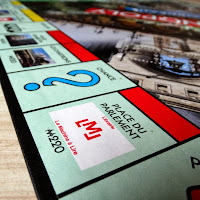The town of Blanquefort, in the second belt of Bordeaux’s northern suburbs, owes its name to this “white fort” (Blanque fortis) which kept watch over the marshy Garonne-side lowlands from the 11th century onwards. Today, the privately-owned site occasionally opens its doors to the general public, and visiting the ruins provides a unique means of instantly rewinding through 1,000 years of history.
Archaeological digs in the area have established that there was human presence here as early as 1200BC. More recent Gallo-Roman period tiles were also uncovered suggesting that there may have been a rudimentary structure designed to monitor movement along the road pictured below, which at the time was the only route into Burdigala (Bordeaux) from the north.
 |
| This was once the main road into Bordeaux from the Médoc! |
Come the 11th century, a stone keep was erected and became the residence
of the Lords of Blanquefort (as referred to in documents dated 1080),
who owned land that stretched from the Garonne to the Atlantic. Despite
being built on a low mound surrounded by a plain, the site’s location continued to prove strategic as
the structure was used to collect “
tonlieu” taxes from those
passing through. Around 1214, a lack of male descendants
resulted in the direct branch of the Blanquefort seigneury family dying out.
By now,
the region had passed under English control and the castle and its land
were acquired in two lots, first in 1257 by Henry III, King of England,
then by his son Prince Edward in 1270 (two years before he himself became
crowned King Edward – he was to reign until 1307). The central
residential section of what was now a royal fortress was now
strengthened by six towers. A stone wall and turrets had also been
erected where a wooden palisade had probably previously stood. The
overall structure was now a bona fide fortress and became the
cornerstone of the area’s system of defence, as a means of regulating
overland access from the north and controlling boat traffic on the
Garonne. At the time, between 20 and 30 soldiers were permanently
stationed here.

As well as the royal throne, Edward I’s successor, Edward II, also inherited a number of debts and so, in 1308, gifted the fortress to one of his creditors, Bertrand de Got, the nephew of Pope Clement V. It was then passed on to Aymeri de Durfort, Lord of Duras, in 1325, before being attributed by the French King Charles VII to Antoine de Chabannes, Count of Dammartin, as a reward for his contribution to the
Hundred Years’ War against the English. Under de Chabannes’ authority, the structure was further embellished with a new grand entrance to the central residential section and the addition of two artillery towers.
 |
| The grand entrance as added in the 15th century. |
 |
| Inside, traces of a spiral staircase on the walls. |
The musical chairs continued around 1466 when de Chabannes swapped Blanquefort for six seigneuries near Paris. Ten years later, the Blanquefort seigneury was returned to the Durforts, who remained at its helm until the 1789 French Revolution, despite having abandoned the fortress as a residential concern in the 17th century after it had come under regular siege during the 16th-century wars of religion.
 |
| The way it was: 1632 picture of the fortress as drawn by the Dutch artist Hermann Van der Hem (source: GAHBLE information panel). |
The 18th century proved fatal for the fortress: the surrounding marshland was drained, robbing the structure of its natural system of defence, and further downstream, Marquis de Vauban implemented
brand new means of fortification to protect the Gironde Estuary. The fortress was abandoned and soon fell into ruins, as much of its stone was used to build other homes in the vicinity.
In 1862, there was a moderate change in fortunes when the fortress became one of the first medieval castles to be listed as one of France's Historic Monuments. In the ensuing years, local “paysans” took up residence in the gatehouse towers and even built a modern house within the fortress walls. As such the structure was inhabited until the 1920s when it was abandoned for good. Ivy soon covered the walls while the ground became a thick carpet of wild vegetation.
In 1962, volunteers set up an archaeological association to study, preserve and "reclaim" the fortress, and extensive digs took place to better understand the structure and its design. Today the fortress and the surrounding land are private property, but upkeep is overseen by a local association, GAHBLE (Groupe d'Archéologie et d'Histoire de Blanquefort). GAHBLE members organise guided tours of the fortress more or less once a month, as well as holding open day events as part of the wider annual European Heritage weekends.
These visits are obviously a great means of getting the bigger picture of what life may have been like within the fortress, but also of uncovering some of its less-expected aspects. In amongst the ruins it is easy to pick out what used to be the kitchen area, the fireplace and the latrines. Countless round shot cannonballs, used to attack the fortress during the wars of religion, must have been gathered together at the time and have not moved in hundreds of years. In some parts the stone flooring is intact and has its own tale to tell as the stone can be traced across Europe to the banks of the Thames and Rhine: the stone would have arrived in the area as ballast to provide stability on cargo ships, and was replaced by wine or other goods for the return trip!
 |
Wartime round shot remnants!
|
Blanquefort’s white fort may no longer serve a practical purpose or dominate the surrounding plains, but it remains a fascinating symbol of how times have changed.
> Find it on the Invisible Bordeaux map: Forteresse de Blanquefort, rue de la Forteresse, Blanquefort.
> GAHBLE website: www.gahble.org






















0 commentaires: